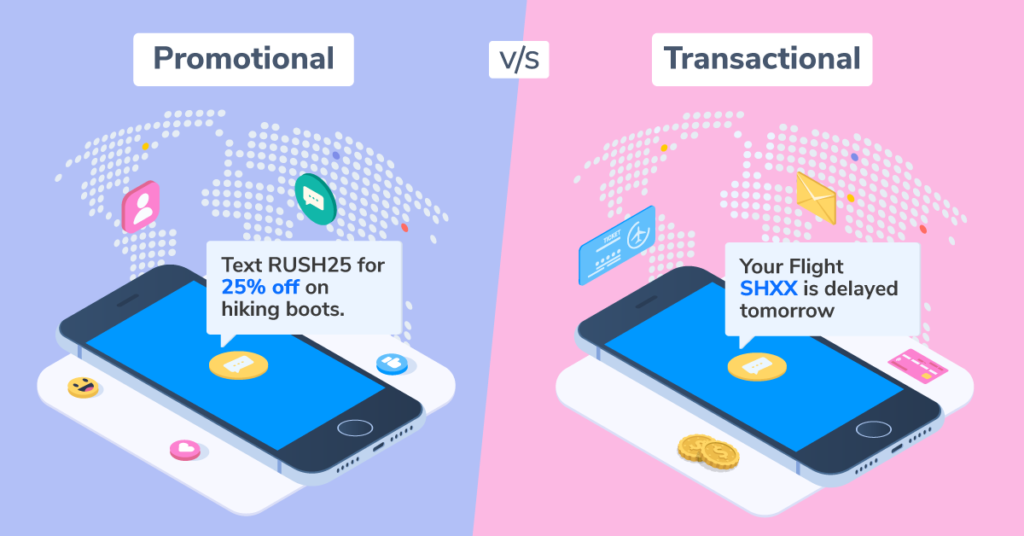
Transactional Messages Are Sent When?
Transactional messages are urgent contacts with your customers or end users that are required.
By providing crucial information when a user needs it most, successful transactional messages lower friction and improve the user experience. Push notifications, text messages, emails, and other types of communication can all be used for transactional communications.
Transactional messaging’s main goal is to offer immediate utility or fulfil a crucial need in the customer journey. Transactional notifications, as contrast to marketing messages, are typically required and anticipated by their recipients.
Without transactional messages, your user can overlook important information and have a disjointed experience. Emails used for authentication, delivery updates, shipping confirmations, account balance notifications, and password reset messages are a few examples of transactional messages.
Different sectors and channels use different types of transactional notifications.
Examples\seCommerce
For instance, after a consumer places an order, the apparel resale app Curtsy sends them a series of transactional messages that allow them to follow the progress of their order all the way up to the point where it is delivered safely to their home.
Push is used to provide order tracking information, to remind sellers to ship orders promptly, to update users of messages they have received, and to offer suggestions to move inventory.
“We needed transactional notifications for that process to function, therefore this [push notifications] was a requirement from day one for us. Transactional communications are sent using email in conventional businesses. We require push notifications because we are a mobile-first business.
Telehealth
Relationships between patients and providers, appropriate care, and adherence to behavioural medicine regimes are all dependent on transactional messaging in the healthcare sector.
In order to encourage in-app symptom tracking and facilitate cross-channel contact between patients and clinicians, Project Rnin had to include a variety of transactional messages when creating a mobile app to enable patients track symptoms between visits and engage with their care team.
They now offer customised transactional messages to users in various treatment cohorts at scale using Mok.one segmentation and personalization capabilities.
Sending mobile push notifications to cancer patients to remind them to report symptoms in between appointments and using in-app messages to inform users about their treatment regimens are two important transactional use cases for their app.
Frameworks for Consent for Transactional and Advertising Messages
Some channels have separate rules for transactional and marketing messaging when it comes to obtaining consent. The steps for obtaining consent for each marketing channel are summarised here.
Notifications through Push
Users must give their consent before sending messages of a transactional or promotional nature over the mobile push channel. On iOS devices, you’ll need the user’s explicit consent before sending them push messages through this channel. On Android devices, you’ll require the user’s implicit consent, however this protocol may change with Android 13.
Currently, in order for your business to send consumers alerts from your app on iOS devices, customers must accept Apple’s native permission question.
Currently, Android-powered devices don’t need a clear opt-in. Instead, users who are only subscribed to this channel have the choice to unsubscribe in each app’s Settings. Users may need to choose to get Android push notifications when Android 13 is released, just as they must choose to receive iOS alerts.
It’s best practise in the realm of email marketing to send your marketing and transactional communications using various dedicated IP and subdomain combinations. This ensures that your crucial transactional emails get to subscribers’ inboxes without a hitch. As these marketing emails are more likely to be banned or delayed, you don’t want to take the chance of mixing up your transactional emails with them. This could jeopardise the delivery of your higher priority messages.
To receive your promotional emails, your receivers are required to opt in. Although regional compliance standards differ, it is advisable to establish compliance with the GDPR, the industry’s strictest email privacy regulation.
According to the GDPR, businesses must obtain recipients’ opt-in consent before sending marketing emails and maintain a record of that consent. Opt-in consent is defined as an agreement that is “freely provided, specific, informed, and unambiguous” and that is “signified by a clear affirmative action.”
Your business must distinguish email consent from other services or acts in order to obtain opt-in consent. It cannot be grouped with privacy notifications or terms and conditions, for example.
Make sure to use an affirmative opt-in, such as an active check of a box, to get consent rather than a pre-checked box.
Explicit consent for email involves a declaration that specifies what you’ll do with a consumer’s data and what kinds of materials they can anticipate receiving. This is vital to keep in mind. You must provide information in this statement about any third parties you share data with, such as your email provider.
SMS (Text Messaging) (Text Messaging)
For both promotional and transactional SMS messages, the same consent is required.
SMS requires a different opt-in procedure than those for other mediums. Customers must consent to receiving your SMS through a different route in order to adhere to the Telephone Consumer Protection Act’s compliance requirements (TCPA).
In accordance with compliance rules, you must obtain users’ opt-in before deploying SMS and offer an easy and clear way for them to opt-out. Mobile companies can obtain SMS opt-ins by asking customers to opt-in for text messaging when they sign up for updates via another channel, like email, or through web pop-ups.
Free Mok.one Account Creation: Send Messages Now
Mok.one is made to assist you in managing user communication across a variety of channels, including email, in-app chat, bulk SMS, and push notifications for mobile and web. Our platform is simple to set up and makes it simple to send messages that are visually appealing without having to do any coding effort. If you don’t already have one, you can sign up for Mok.one for no cost and start notifying your users of updates right away. Sign up now and see for yourself, don’t take our word for it!
